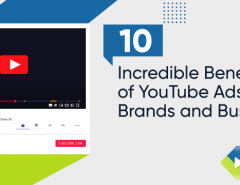Last Updated on April 13, 2022
Video marketing is completely changing the way content on the internet is created and processed. If you were fortunate enough to experience the internet in its infancy back in the late 90s and early 2000s, what you will have remembered was an online world of slow, static content and only dreams of what the future might look like with online video. Back then the internet was clunky, dial-up was your best bet for getting online and the most engagement you might find on a website, was an animated gif.
Today, all of that has changed. Thanks to the massive advancements in technology, internet speed and of course mobile — video is now the standard for content engagement online. Though text and images are still used on a small scale, it is the influence, engagement, and numbers behind video that is driving businesses and brands around the world crazy. They just can’t create enough videos to get in front of their audience.
Throw mobile marketing and content creation into the mix and you have a whole new beast. Mobile usage is on the rise and while less people are using desktops and laptops for online searching, video views continue to rise thanks to mobile applications like Google, YouTube, Facebook and Snapchat.
In short… if you aren’t currently using video in your content creation and marketing efforts, you are missing out big time!
The Rise of Video Marketing
With all of this talk on video and the importance of implementing it into your existing business and brand, we thought it would be a great idea to feature an infographic loaded with industry stats on such a hot topic. The infographic featured below was created by InfographicDesignTeam.com, and we’ve taken the time to break it down in both written and visual form. Enjoy!
First, let’s take a look at the video environment on the internet today. Even if you weren’t actively using your mobile device, you would still see video is now used for content creation and marketing than ever before. Billions of views are served daily through sites like Facebook, YouTube, Vimeo, Netflix and Amazon — and that’s not even counting mobile usage!
To get a better idea on when and where video is being accessed, let’s break down these numbers.
- 55% of people watch videos online every day.
- Online video now accounts for 50% of all mobile traffic.
- 78% of people watch videos online every week.
- 52% of marketers believe that video marketing is effective for brand awareness, lead generation (45%), and online engagement (42%).
- Last year online video accounted for 64% of all consumer internet traffic and this number is expected to rise to 69% by 2017 and 79% by 2018.
- 85% of respondents who are already using video marketing found it to be fairly or extremely successful.
- The same survey also reported a massive 81% of people featuring videos on their brand websites.
- Social video generates 1200% more shares than text and images combined. Companies using video enjoy 41% more web traffic from search than non-video users.
- 70% of marketers claim video produces more conversion than any other content.
- 4.8% is the average conversion rate for websites using video compared to 2.9% for those who don’t.
- 4 times as many consumers would rather watch a video about a product than read about it.
As you can see from the stats above, brands and businesses that aren’t currently using video within their content creation and marketing efforts are quickly going to fall behind. While text and image content is great for search ranking and research, more users are focusing on immediate gratification and engagement.
As with all changes over the past two decades, Google will quickly adapt and find new ways to deliver video content over boring text and images — which means every business needs to start aggressively building out their own video content immediately.
To help with this process, follow the 9 tips for successful video marketing campaigns in 2016, found below.
- Set Your Budget and Expectations Straight
Before going live with your first video content creation and promotion campaign, you need to have a budget in place. There is a lot more to video production than just going live with it. You may need to invest in a script, a brand or logo identity, designers and animated video work. Know your costs before getting in too deep. - Develop an Appealing Story for Your Video
The script creation process for your video can be down by your own team or outsourced to another. No matter what option you choose, make sure your video brings your message to life and engages with your audience in the way you want. - Stick to a Schedule
Knowing your audience is one of the most important steps to converting them into a paid customer or lead. This also means knowing how to lay out your videos, how long they should be and the call to action for each. Be sure to include these points when setting everything up for your video script and production. - Promote Your Snapchat Stories Every Time You Post Them
Simply creating and posting content on any social or media platform isn’t enough, you need to have a promotion method in place as well. Share your Snapchat videos with your audiences and try to increase your following through other social networks like Facebook, LinkedIn and Twitter. - Use Video on Your Landing Pages
Landing pages are one of the most efficient ways to convert an audience into a high-quality lead. Adding video content to such landing pages can significantly increase conversions as well. Explainer and whiteboard videos work extremely well, and some have been proven to increase conversions by 80% or more. Don’t forget to add your call-to-action within your videos as well. - Ideal Video Length is 60 Seconds
Most content creators and brands want to create very detailed and long videos — however, that is exactly the opposite of what your audience wants to see. They want immediate gratification and are quickly losing interest with each second that passes by. - Facebook Video Generates Higher Engagement
There are well over 1.5 billion users on Facebook, many of which who are accessing and viewing video content daily. Facebook Ads is now offering self-serve advertising of video ads through their platform as well. With video advertising and demographic targeting now available, online video campaigns are simply more effective than ever before. - Optimize Your Videos for the Search Engines
From an SEO perspective, there are a few different things you can do to improve your chances for video ranking in Google’s organic search results.
– Create an SEO strategy and come up with keywords for your videos.
– Make sure you relevant tags.
-Use the focus keyword at least once in the title and description of your video.
Always provide additional links in the video description box like contact information, special offers, promotion, events and more. - Post the Video in Multiple Places
Once your video is live for the world to see, it’s then time for you to focus on your video marketing efforts. Outside of your own website, blog and social media profiles, you should be promoting your videos wherever possible. If you have a mailing list, be sure to let everyone know about your latest videos and where they can find them.
How to Use Video Marketing for Your Brand or Business
At the end of the day, video is quickly becoming more important for branding, marketing and lead generation online. It isn’t a question of when you need to start focusing your efforts on video content creation, it’s simply a question of how.
To learn more about how you can start turning your existing brand content into animated video and converting your audience into paying customers like never before, click here to contact our design team. We’ve worked closely with thousands of brands from around the world and helped them take advantage of what online video has to offer.
To see some examples of our previous work, head over to our animated video portfolio page.





